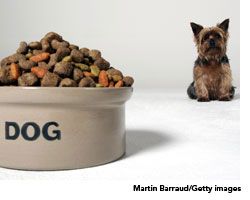Consumer Reports tackles pet food
Veterinary expert Dr. Ernie Ward says that if clients ask questions as a result, it's a chance for you to bond.

More expensive pet food isn't always better quality, according to a story in the March 2009 issue of
Consumer Reports
. The consumer advocacy magazine talked to eight pet nutrition experts at universities nationwide and concluded that a higher price may mean better ingredients and quality control-or just good-looking packaging and more money spent on marketing.
The story doesn't encourage consumers to talk to veterinarians (click here to read the whole story), but it does offer information on what pet food labels really mean as well as these three tips for pet nutrition:
1. Pet owners should be careful if they make their own pet food. The article warns pet owners about the risks of contamination, unhealthy ingredients, and unbalanced nutrition. It also guides consumers to online resources for homemade pet food information: The American College of Veterinary Nutrition and the Web sites petdiets.com and balanceit.com.
2. Age-appropriate diets are important. Foods labeled “for growth” or “for all life stages” meet the needs of kittens, puppies, and pregnant pets, the authors state. Foods marked “for maintenance” are for healthy adult animals. “Senior” is a marketing term, not a nutritional term, according to the article.
3. Wet foods are more expensive per calorie per serving than dry foods, because wet foods contain 75 percent water.
Veterinary Economics Editorial Advisory Board member Dr. Ernest Ward Jr. loves it when stories about pet products show up in Consumer Reports and other watchdog magazines. “I encourage clients to be curious and inquisitive,” Dr. Ward says. “These types of clients are the most exciting ones. They're really being advocates for their pets.”
If clients question Dr. Ward's pet food recommendations, he doesn't take it personally. “I don't get defensive. I don't assume I have all the answers,” he says. When Dr. Ward's clients bring him mainstream news stories on veterinary care or pet health conditions, he takes the articles, reads them, then calls or e-mails the client with his response.
He also isn't perturbed when a client doesn't agree with his pet food choice. He's toured pet food manufacturing facilities, explored nutrition companies, and trusts the products, so he can explain his recommendations thoroughly. He encourages clients to ask the same questions and do the same type of research. Transparency and open conversations usually lead to smiles all around.
For client handouts on pet nutrition and exercise, see the Related Links below.